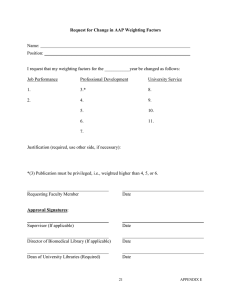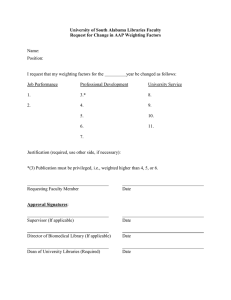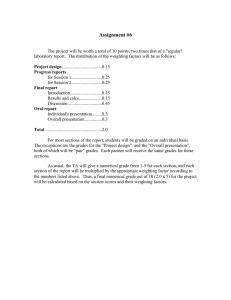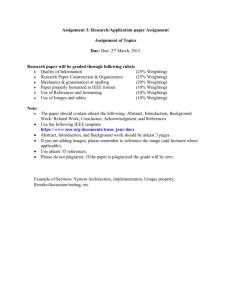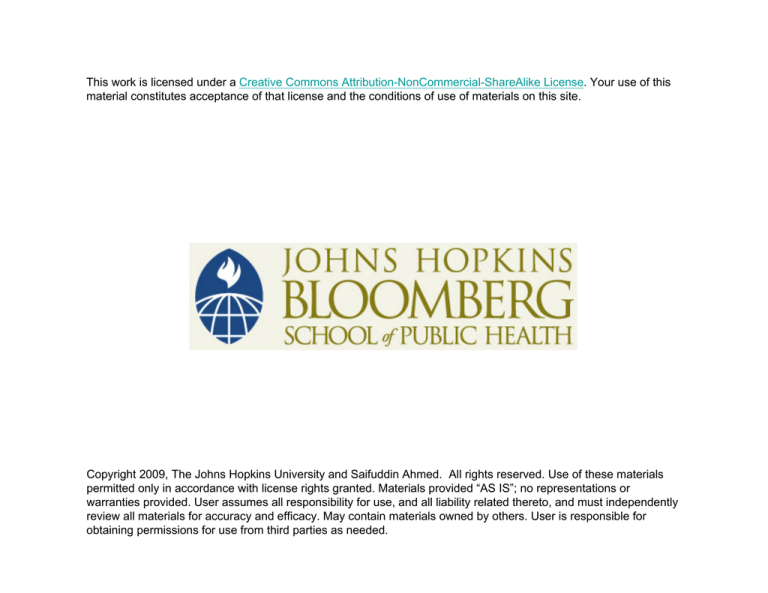
This work is licensed under a Creative Commons Attribution-NonCommercial-ShareAlike License. Your use of this
material constitutes acceptance of that license and the conditions of use of materials on this site.
Copyright 2009, The Johns Hopkins University and Saifuddin Ahmed. All rights reserved. Use of these materials
permitted only in accordance with license rights granted. Materials provided “AS IS”; no representations or
warranties provided. User assumes all responsibility for use, and all liability related thereto, and must independently
review all materials for accuracy and efficacy. May contain materials owned by others. User is responsible for
obtaining permissions for use from third parties as needed.
Methods in Survey Sampling
Biostat 140.640
weighting
Saifuddin Ahmed, PhD
Dept. of Biostatistics
Sample Weighting
• The purpose of weighting sample data is to
improve representativeness of the sample in
terms of:
– size
– Distribution, and
– characteristics of the study population.
• By introducing sampling weight, the estimation is
carried out in such a way that the estimates
reflect the actual distribution/characteristics of
the population.
Population total estimate from sample:
T ( y ) = N * y,
where y is the estimated mean
We may rewrite this as:
N
T ( y) = * n * y
n
By multiplying the “inverse
of sample selection
probability” with a “sample”
estimate, we may derive a
“population” level estimate.
An example
•
•
•
•
N = 300,000
n = 300
Sampling fraction (f) = 300/300,000 = 0.1
y_bar(mean) = 0.5 (50% of children are
immunized)
• Total Y = (1/f)*(n*y_bar) = (1/0.1)*300*0.5
=150,000
• The inverse of the selection probability
(w=1/f=N/n) is used as a weight to make the
estimate equal to the population
• Even when the sample is selected with different
selection probabilities, the same principle could
be extended, and the weight is inversely
proportional to the unit selection probabilities.
• The weights as measured from the inverse of
the selection probabilities are called design
weights.
Inverse of the sample selection probability
is the design weight.
The sum of sampling weights is equal to
the population size N
ta v005
weight |
Freq.
Percent
Cum.
------------+----------------------------------199788 |
326
5.15
5.15
203687 |
107
1.69
6.84
342747 |
91
1.44
8.27
352024 |
312
4.93
13.20
473247 |
262
4.14
17.33
571152 |
248
3.91
21.25
726240 |
267
4.21
25.46
728423 |
128
2.02
27.48
792283 |
81
1.28
28.76
836419 |
187
2.95
31.71
845095 |
294
4.64
36.35
851062 |
138
2.18
38.53
907765 |
384
6.06
44.59
930111 |
242
3.82
48.41
967833 |
134
2.12
50.53
979842 |
391
6.17
56.70
1005824 |
348
5.49
62.19
1026552 |
67
1.06
63.25
1068896 |
145
2.29
65.54
1083215 |
496
7.83
73.37
1095179 |
79
1.25
74.62
1106982 |
120
1.89
76.51
1224149 |
417
6.58
83.09
1312089 |
76
1.20
84.29
1465329 |
884
13.95
98.25
1608275 |
111
1.75
100.00
------------+----------------------------------Total |
6,335
100.00
When weighting is needed?
• Different selection probabilities
• Need of improving the variance estimation
in case of:
– High non-response and coverage errors
– Departures from representative(probability)
sampling
– Small sample sizes
Why do we weight?
• To improve representativeness of the
sample in terms of size, distribution and
characteristics of the study population.
• to ensure that the estimates are simple
unbiased estimates.
Weighting, however, is not
without problems.
Advantages of such self-weighed
sampling designs
• Weighting increases complexity of the survey operations
• Haphazard weights which are not related to population
variances increase variance of the survey estimates.
• Weighting may reduce the flexibility and ease with which
the same sample may be used for diverse purposes and
different surveys.
• Repeated sampling from the same list is straight forward
with self-weighting, but the selection probabilities
become more complex if previous selections from the
frame were not with equal probabilities.
• Self-weighted samples are more readily understood and
accepted by the non-statistical and the general public.
• Moderate departures from self-weighting have small
effect on variances, and weighting is only suggested
when the estimates involves large departures with self
weighted samples.
When to weight?
• For appropriate representativeness of
smaller domain (e.g., residence,
geographical territories, race, sex )
• Fixed sample size for different
geographical areas
• Defect in sampling frame, errors in
selection, high non-response
Disadvantages
• Increased complexity
• Inconvenience
• Increased variance with haphazard
weighting
• Analysis /statistical programming
• Cost
• Higher possibilities of error
• Increased bias with incorrect weight
Major reasons of weighting in
practice
• Departures from self-weighting
• Frame defects
• Nonresponse
Region = A
N =50,000
n=500
P=0.5
Region = B
N =15,000
n =500
P=0.6
(# immunized=500*.5
=250)
(# immunized=500*6
=300)
Region = C
N =30,000
n=500
P=0.7
Region = D
N =5,000
n=500
P=0.8
(# immunized=500*.7
=350)
(# immunized=500*.8
=400)
Then, sample based immunization rate in the country is:
(250+300+350+400)/(500+500+500+500)= 1300/2000 = 65%
Nh
wh =
nh
50,000
wA =
= 100
500
15,000
wB =
= 30
500
30,000
wC =
= 60
500
5,000
wD =
= 10
500
t=
H nh
∑∑
h =1i =1
wh yih
t
y=
∑ wh
. di (100*.5+30*.6+60*.7+10*.8)/ (100+30+60+10)
.59
. di (100*250+30*300+60*350+10*400)/ (50000+15000+30000+5000)
.59
Weighted based “unbiased estimate” = 59%

